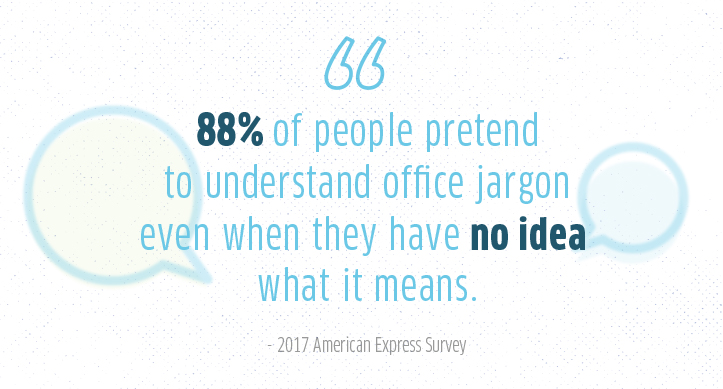Let’s Get Aligned on High-Impact Jargon and Buzzwords

It’s Monday morning (womp) and you’re sitting in your weekly department meeting, walking through priorities. Next on the agenda: the project that has been challenging your team for weeks.
When asked for an update, your coworker says, “We should drill down to the root of the issue with an outside-the-box look at how we can leverage our synergies to achieve our mar-comm goals.”
“Great idea!” someone chimes in. “Let’s utilize those findings to devise actionable insights.”
The meeting leader replies, “Ok, let’s circle back offline about this.” Everyone nods in agreement and the group moves on to the next agenda item.
Wait, what?! Was anything just accomplished? What was even said? For many of us, this exchange is more daily reality than fictional scenario. Workplace communication has become so riddled with buzzwords and jargon that often times, we don’t even know what we’re agreeing to.
That's a problem.
Drilling Down on Definitions
First off, what do I mean by buzzwords and jargon? Depending on who you ask, you’ll get a variety of definitions.
Jargon can be defined as special words or expressions that are used by a particular profession or group and are difficult for others (or “outsiders”) to understand. Think “SaaS,” “CTR,” or “The Cloud.”
A buzzword is a slogan, word or phrase, often an item of jargon, that is fashionable at a particular time or in a particular context. Examples include “omnichannel,” “hyperlocal” and “disruptive,” as well as phrases like “low-hanging fruit” and “think outside the box.”
While the terms “buzzword” and “jargon” have two distinct definitions, they’re closely related and wreak similar havoc, so I’ll be using them interchangeably throughout this blog.
The Value-Added ROI of Buzzwords
Buzzwords may make us cringe, but it’s important to remember that we all use them, and that’s because they do serve a purpose.
Benefit #1: Verbal Shortcuts
Buzzwords allow associates in the same company or industry to communicate in a way that avoids re-explaining concepts that are common knowledge. It’s much easier, for example, to say “The Cloud” than it is to describe a SaaS model or “utility computing” every time there’s a meeting.
Benefit #2: Community
Buzzwords and jargon create a feeling of connection by solidifying a team environment. At work, if you’re up on the lingo, you’re part of the in-crowd.
Benefit #3: Demonstrate Expertise
If your audience is a community with a strong grasp of the industry, you can set yourself up as an expert with the use of jargon. By going beyond basic explanations, you establish authority.
Too Much of a Good Thing
There's nothing wrong with wanting to be an insider or hoping others see you in a positive light. That's human nature. The danger comes when we overuse buzzwords, ignore who our audience is, or use jargon to detract from the fact that we don’t have a clear grasp of the topic we’re discussing. As digital marketers, we fall into one of the most notorious categories for jargon use. Marketing is already a buzzword-laden industry. Layer in technology, and you have a potentially disastrous situation.
Danger #1: Lost Impact
Buzzwords and jargon can easily become a crutch for marketers. That sort of practice leads to a flood of tired, hollow marketing babble that no longer carries any meaning. We become desensitized to words we hear over and over again. If your mind instantly wanders when you hear the phrase “big data,” then you know exactly what I’m talking about. Jargon has gotten so out of hand that companies like Grant Thornton have actually devised a Business Jargon Index to monitor the most overused buzzwords in Fortune 500 companies.
Danger #2: Annoyance
Buzzwords don't just become meaningless over time, they become irritating. Everyone’s time is precious, and no one wants to spend that time trying to decipher what’s really being said. Inappropriate use of jargon is like someone starting a sentence with “No offense, but…” You’re definitely offended and will almost certainly disregard any other words that follow.
Danger #3: Mistrust
Perhaps worse than reduced impact and increased frustration is the potential loss of trust that comes with overuse or misuse of buzzwords. A recent study revealed that people who use buzzwords instead of using concrete language are more often perceived as lying.
Danger #4: Misunderstandings
Our clients don’t live and breathe marketing trends. That’s part of why they pay us. So they probably don’t have the same understanding of the jargon we use daily. Meetings riddled with buzzwords are akin to putting a French speaker and a Japanese speaker in the same room and expecting a productive conversation.
This isn’t just a client/agency challenge. It permeates internal communication too. Remember when I mentioned a positive attribute of jargon is that it makes us feel as though we’re a part of the in-crowd? It’s that very same desire to be a part of a community that causes hesitancy to speak up when we’re confused. When we don’t understand but feel like we should, we don’t say anything for fear of revealing that we aren’t insiders. A 2017 survey by American Express Open found that 88 percent of people pretend to understand office jargon when they have no idea what it means. That’s alarming.

Ok, Give Me Some Actionable Insights
Again, buzzwords and jargon have a place. But they are chronically misused across all industries. Here are a few tips to communicate more effectively.
Tip #1: Think of Your Audience
Always start with the perspective of your audience by asking yourself: “Are these the exact words my reader/client/customer would use?” Seth Godin’s latest book, “This Is Marketing,” touches on this concept. “Match the worldview of the people being served,” writes Godin. “Show up in the world with a story that they want to hear, told in a language they’re eager to understand.”
Tip #2: Say What You Mean
Being direct is challenging, but it makes you a better communicator. If you have to make a choice between being too simple or too sophisticated, err on the side of making it too simple. You will never hear a client complain, “This brochure (or landing page, or proposal, or diagram, or...) is too easy to understand.”
Tip #3: Speak Up
Don’t be part of the 88%. Raise your hand if something doesn’t make sense. You probably aren’t the only person in the room who wants clarity. And speak up at the beginning of a project. While you may be nervous to ask for clarification during a kick-off, you’ll feel much sillier when you have to ask about something you’ve been pretending to understand for months.
Tip #4: Ask for Specificity
We are all guilty of using buzzwords every once and while to compensate for the fact that we aren’t sure of what we’re truly explaining or on the direction we want to give others. But it’s better to get specific up front. If someone tells you “We need a roadmap for this,” ask them to explain what they are envisioning in more detail. Is it a one-year plan with milestones to achieve a goal? Is it in the form of a slide deck? A word document?
At the End of the Day
As marketers, it’s part of our job to identify trends, light them on fire and watch them spread. But sometimes our devotion to trends can lead to overdoing it, as is the case with buzzwords and jargon. This causes confusion and frustration and impacts our work.
We have a responsibility to know our audience and effectively communicate to them. The more we work to simply and directly share ideas, the more productive we’ll be. Who knows? By thinking twice, you may never use the phrases “low-hanging fruit” or “circle back” again.

Comments
Add A Comment